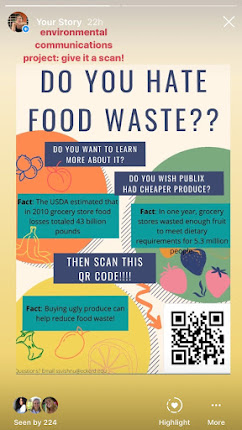Food Waste Communication and Advocacy
Food waste is an issue that is often overlooked. Here are some disturbing facts:
- The US loses 40% of the food it produces in the journey from farms, grocery stores, and our homes to landfills across the country. (NRDC)
- Approximately 165 billion pounds of food are thrown away every year. (NRDC)
- According to ABC7 news, America’s food waste could fill 730 football stadiums every year (cited by Oliver, 2015)
- Food waste has increased by about 50% in less than 40 years (Hall et al. 2009)
- 13.7 million households were food-insecure in 2019 (USDA)
- Food waste in landfills also produces a significant amount of methane, a greenhouse gas which “In the first two decades after its release, … is 84 times more potent than carbon dioxide.”(EDF)
Because of these facts we decided to center our communication project around the reduction of food waste. Our communication project had three key elements: A poster, a Linktree website, and an email petition for viewers to take action to reduce food waste in St. Petersburg.
Once we identified the issue/topic we wanted to tackle we then had to decide the audience we wanted to communicate our message to because we know that audience identification (Pezullo and Cox, 2018) is an important part of environmental communication. We decided to disseminate our message to the Eckerd community and other college age students, because we ourselves are college students, we knew that postering and social media were great ways to reach these audiences!
We also wanted to incorporate advocacy by providing a way to take action. To do this we decided to target a specific contributor of food waste- a grocery chain called PUBLIX. When designing our poster we wanted it to be both educational and actionable so we decided to implement some hypermediacy (Pezullo and Cox, 2018) through a QR code.
The QR code brings viewers to our Linktree (check it out!) which incorporates hypermediacy, using multiple forms of media to help us communicate multiple things at once. Our Linktree sends viewers to three pieces of media; an educational video about food waste by John Oliver, an email petition asking Publix to implement a clearance produce section, and finally a link to the NRDC report which is full of facts about food waste in the U.S.
The deficit model of communication relies on the public as an empty vessel waiting for new facts (Pezullo and Cox, 2018). We tried to avoid using this model by including comedy by John Oliver, and providing an actionable item for viewers to take an active role in the communication, rather than just receiving it. By giving our audience this opportunity we also make sure to educate the viewers that food waste is not just a consumer issue. We felt this was important because the dominant discourse, or the popular understanding of the issue (Pezullo and Cox, 2018), focuses on individual production of food waste rather than holding other sources of food waste accountable such as farms and grocery stores. Using advocacy strategies, we identified Publix as our primary audience (Pezullo and Cox, 2018), a key decision maker, because they are able to implement policies that could have real effects on the amount of food that gets sent to landfills. This means that our secondary audience (Pezullo and Cox, 2018), the people who will get Publix to care, are our viewers who we hope will help pressure Publix into change.
We circulated 60 posters around campus covering the academic side, dorms, and the cafeteria. We also then posted our communication piece on our instagram stories and linked the Linktree in our bios for our followers to interact with. In total, 27 people clicked on our Linktree, 13 of those 27 people reached it through our posters. This result is a little disheartening since our original goal was to get 100 people to access our Linktree.
 |
| Our poster up on Instagram: 224 views |




Comments
Post a Comment